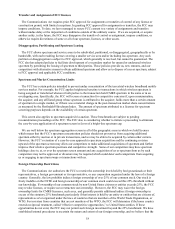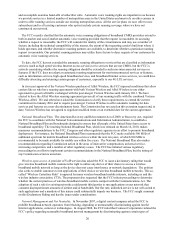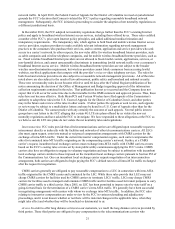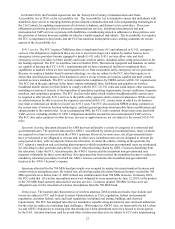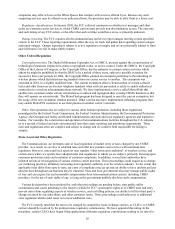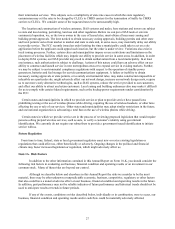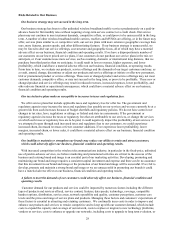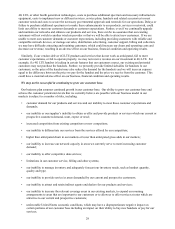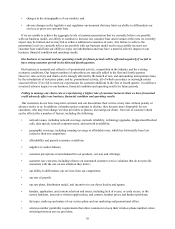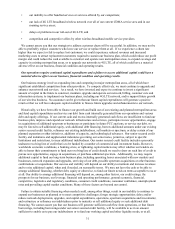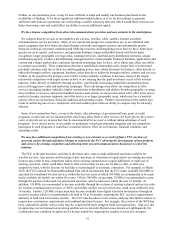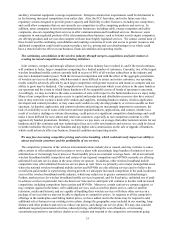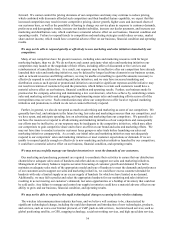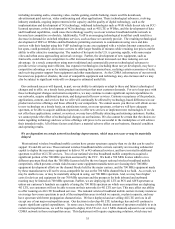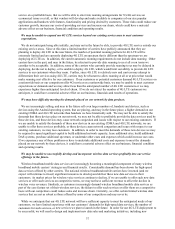Metro PCS 2010 Annual Report Download - page 37
Download and view the complete annual report
Please find page 37 of the 2010 Metro PCS annual report below. You can navigate through the pages in the report by either clicking on the pages listed below, or by using the keyword search tool below to find specific information within the annual report. 27
their termination services. This subjects us to a multiplicity of state rate cases in which the state regulatory
commission may set the rates to be charged by CLECs to CMRS carriers for the termination of traffic by CMRS
carriers to CLECs. We consider some of the requested rates to be unreasonably high.
The location and construction of wireless antennas, DAS systems and nodes, base stations and towers are subject
to state and local zoning, permitting, land use and other regulation. Before we can put a DAS node or site into
commercial operation, we, or the tower owner in the case of leased sites, must obtain all necessary zoning and
building permit approvals. The time needed to obtain necessary zoning approvals, building permits and other state
and local permits varies from market to market and state to state and, in some cases, may materially delay our ability
to provide service. The FCC recently issued an order limiting the time a municipality could take to act on a site
application before the applicant could appeal such inaction, but the order is under review. Variations also exist in
local zoning processes. Further, certain cities and municipalities impose severe restrictions and limitations on the
placement of wireless facilities which may impede our ability to provide service in some areas. In addition, in order
to deploy DAS systems, our DAS provider may need to obtain authorization from a local municipality. In at least
one instance, such authorization is subject to challenge. Actions of this nature could have an adverse effect on our
ability to construct and launch service in new metropolitan areas or to expand service in existing markets. Further,
we may be subject to environmental compliance regulations with respect to the operation of standby power
generators, batteries and fuel storage for our telecommunications equipment. A failure or inability to obtain
necessary zoning approvals or state permits, or to satisfy environmental rules, may make construction impossible or
infeasible on a particular site, might adversely affect our network design, increase our network design costs, require
us to use more costly alternative technologies, such as DAS systems, reduce the service provided to our customers,
and affect our ability to attract and retain customers. Local zoning and building ordinances also may make it difficult
for us to comply with certain federal requirements, such as the backup power requirements under consideration by
the FCC.
Certain states and municipalities in which we provide service or plan to provide service have passed laws
prohibiting texting or the use of wireless phones while driving, requiring the use of wireless headsets, or other laws
affecting the use or sale of our services. Other states and municipalities may adopt similar restrictions in the future,
and one national organization is advocating a total ban on the use of wireless phones while driving.
Certain states in which we provide service are in the process of reviewing proposed legislation that would require
persons selling prepaid wireless services, such as ours, to verify a customer’s identity using government
identification. We currently do not require our subscribers to provide a government issued identification to initiate
service with us.
Future Regulation
From time to time, federal, state or local government regulators enact new or revise existing legislation or
regulations that could affect us, either beneficially or adversely. Ongoing changes in the political and financial
climate may foster increased legislation or regulation, which might adversely affect us.
Item 1A. Risk Factors
In addition to the other information contained in this Annual Report on Form 10-K, you should consider the
following risk factors in evaluating our business, financial condition and operating results or an investment in our
common stock. Many of these risks are beyond our control.
Although we describe below and elsewhere in this Annual Report the risks we consider to be the most
material, there may be other unknown or unpredictable economic, business, competitive, regulatory or other factors
that also could have a material adverse effect on our business, financial condition and operating results in the future.
In addition, past performance may not be reliable indicator of future performance and historical trends should not be
used to anticipate results or trends in future periods.
If any of the events, conditions or risks described below, individually or in combination, were to occur, our
business, financial condition and operating results and/or cash flow could be materially adversely affected.



